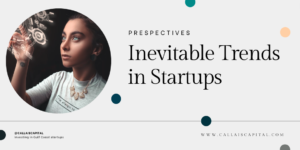
As venture investors, we are always tracking trends and performing market research to figure out how economic forces impact future businesses. What changes the world around us are ever-evolving market conditions. These shifts open up doors for creative entrepreneurs looking to forge new paths and new business ideas. But you must separate inevitable trends from fads. Recently we’ve been following a few markets we see with strong roots, great opportunity, and industry growth. Here are a few.
Decentralization
Many companies are abandoning their expensive office spaces and going virtual. Employees are rehabbing spare bedrooms into offices and operating out of coffee shops and co-working facilities. The rise in gig economies and decentralized workplaces is obvious. The gig economy alone grew 30% during the pandemic and the gig workforce is now on track to surpass the full-time workforce by 2027. According to Gallup, before the pandemic, only about 8% of remote-capable employees worked from home with about 1/3 working a hybrid schedule. As many as 70% worked exclusively from home in May of 2020. As of February 2022, 42% work a hybrid schedule and 39% work entirely from home.
The decentralized workplace is already having a drastic effect on the way we do businesses. With most companies relying strictly on cloud computing, security risks have become more common. 78% of security and IT leaders say that remote workers are simply harder to secure. More trust is placed on web applications and video-conferencing platforms. As working from home becomes the new norm, business opportunities grow.
Consumer Experience
Companies are constantly reimagining better ways to connect with their customers, reinventing touch points and customer journeys. We’ve seen the rise in automation tools, chatbots (ChatGPT), and customer relationship management (CRM) platforms. Outreach is becoming more personal and 1:1. Buzzwords like Web3.0 and metaverse are being thrown around as the future. Aside from fully-immersive gaming and entertainment experiences, the metaverse does have the potential to change the face of communications, retail, education, real estate, and more. Augmented reality is also offering opportunities to interact with the world around us in a new and unique way. Whether these fad terms become inevitable trends in our lifetime is unknown, but the underlining theme is true. Customer relationships are changing.
According to a survey by Entrust, 64% of consumers are willing to trade their personal data for personalized services. But a growing number – 79% – are concerned about their data privacy. How will future businesses juggle these privacy concerns while also improving customer loyalty, driving new business, and embracing new technology?
Supply Chain
The severity and frequency of supply chain disruptions are increasing. Product shortages, shipping delays, and price hikes are all too common. The pandemic has made it glaringly obvious that there are fundamental supply chain issues that aren’t going to sort themselves out. This isn’t just impacting large businesses, though. 86% of small and midsize business supply chains have been affected. We need innovative market solutions to emerge.
McKinsey found that companies experience a one-to-two-month disruption approximately every 3-7 years. The financial fallout of such supply chain disruptions in the consumer goods sector could equal 30% of a year’s EBITDA in a 10-year span. Resilient supply chains keep companies running efficiently despite the quickening pace of disruptions. But this is something that needs to change so that consumers aren’t hit with a supply shortage or price increase. There are many companies that are trying to simplify this process by leveraging blockchain, 3D printing machines, and localized supply solutions.
Health and Wellness
According to the Global Wellness Institute, the health and wellness industry is forecast to grow at an average rate of 9.9% a year. McKinsey sees it as a $1.5 trillion wellness market. One positive to come out of the pandemic is the importance of mental health and work-life balance. Healthy lifestyle habits such as eating better, going to the gym, managing weight, and lowering stress are all predicting growth within the industry.
Blue Economy
Aside from being a moving force of commerce, the ocean has absorbed 90% of the planet’s warming in recent decades. From sea level rise to ocean acidification, it disproportionately exhibits the impacts of climate change. America’s Blue Economy supports 2.3 million jobs and contributes $373 billion to our GDP annually. It’s vital to learn what the oceans are telling us and use that information to prepare sectors of our economy for climate. It impacts recreational activities, energy, research, and shipping. So, how do we innovate the tools, data, and services and create a greener approach?